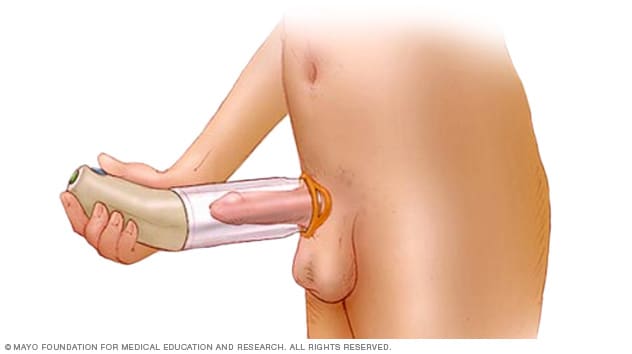Erectile dysfunction: Nonoral treatments
Oral medications aren’t the only way to treat erectile dysfunction. Know the full range of treatment options and how they work.
By Mayo Clinic Staff
If you have erectile dysfunction and can’t take certain oral medications or if oral treatments aren’t effective, you have other treatment options.
Understand why you might choose a nonoral treatment for erectile dysfunction and how these different treatments work.
When oral medications might not be safe
Not all men can safely take erectile dysfunction oral medications, such as sildenafil (Viagra), vardenafil (Levitra, Staxyn), tadalafil (Cialis) and avanafil (Stendra). Medications for erectile dysfunction might not work or might be dangerous if you:
- Take nitrate drugs commonly prescribed for chest pain (angina)
- Have very low blood pressure (hypotension) or uncontrolled high blood pressure (hypertension)
- Have severe liver disease
- Have kidney disease that requires dialysis
Some men might also choose another treatment option to avoid the side effects caused by certain oral medications.
Other types of medications
Nonoral medications for erectile dysfunction include:
-
Self-injections. Several medications are commonly injected directly into the penis to achieve an erection. The most often used medications include alprostadil, papaverine, and phentolamine. With this method, you use a fine needle to inject the medications into the base or side of your penis.
The goal of injection therapies is to produce an erection that lasts about 20 to 40 minutes. If an erection lasts longer than one hour, you will need to have the medication or dose adjusted to avoid potentially long-term complications. Because the needle used is very fine, pain from the injection site is usually minor.
Side effects can include bleeding from the injection, prolonged erection (priapism) and formation of fibrous tissue within the penis or at the injection site.
-
Alprostadil urethral suppository. Alprostadil intraurethral (Muse) therapy involves placing a tiny alprostadil suppository inside your penis in the penile urethra. You use a special applicator to insert the suppository into your penile urethra.
The erection usually starts within 10 minutes and lasts between 30 and 60 minutes. Side effects can include pain, minor bleeding in the urethra and formation of fibrous tissue inside your penis.
-
Testosterone replacement. Some men have erectile dysfunction that might be complicated by low levels of the hormone testosterone. In this case, testosterone replacement therapy might be recommended as the first step.
Testosterone replacement therapy can be delivered via injection, patch, gel, gum and cheek (buccal cavity), intranasal, subcutaneous pellet, or oral medication. Talk to your doctor about your personal preference and the possible side effects.
Penis pumps, surgery and implants
If medications aren’t effective or appropriate in your case, your doctor might recommend a different treatment. Other treatments include:
-
Penis pumps. A penis pump (vacuum erection device) is a hollow tube with a hand-powered or battery-powered pump. The tube is placed over your penis, and then the pump is used to suck out the air inside the tube. This creates a vacuum that pulls blood into your penis.
Once you get an erection, you slip a tension ring around the base of your penis to hold in the blood and keep it firm. You then remove the vacuum device.
The erection typically lasts long enough for a couple to have sex. You remove the tension ring after intercourse. Bruising of the penis is a possible side effect, and ejaculation will be restricted by the band. Your penis might feel cold to the touch.
If a penis pump is a good treatment choice for you, your doctor might recommend or prescribe a specific model.
-
Penile implants. This treatment involves surgically placing devices into both sides of the penis. These implants consist of either inflatable or semirigid rods. Inflatable devices allow you to control when and how long you have an erection. The semirigid rods keep your penis firm but bendable.
Penile implants are usually not recommended until other methods have been tried first. Implants have a high degree of satisfaction among men who have tried and failed more-conservative therapies. As with any surgery, there’s a risk of complications, such as infection.
- Blood vessel surgery. Rarely, erectile dysfunction is treated by bypassing obstructed penile arteries. This is uncommon, however, and is only recommended in a small percentage of men.
Psychological counseling
Battery-powered penis pump for erectile dysfunction
Battery-powered penis pump for erectile dysfunction

Battery-powered penis pump for erectile dysfunction
A penis pump is used to draw blood into the penis to create an erection. You then place a rubber ring around the base of the penis to maintain the erection.
If your erectile dysfunction is caused by stress, anxiety or depression — or the condition is creating stress and relationship tension — your doctor might suggest that you, or you and your partner, visit a psychologist or counselor.
Don’t ignore the underlying cause
Getting proper treatment for the underlying cause of erectile dysfunction might help prevent related health problems and improve sexual function. Conditions that can cause or worsen erectile dysfunction include:
- Heart disease
- Diabetes
- Obesity
- Psychological issues
- Alcoholism and other forms of substance abuse
- Tobacco use
If you have erectile dysfunction, you’re not alone — and you have many treatment options. Work with your doctor to find which erectile dysfunction treatment might work best for you.
July 02, 2021
See more In-depth
Products and Services
.
For all the latest Health News Click Here
For the latest news and updates, follow us on Google News.
